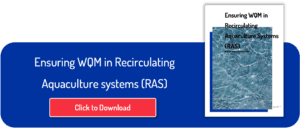
Fish farming, also known as aquaculture, is an industry that provides a significant portion of the world’s food supply and is growing in volume. While fish farming offers numerous benefits, such as increased food production and reduced pressure on wild fish populations, it also comes with certain risks. One of the significant dangers in fish farming operations is the presence of gas excreted from the fish themselves and the added gas to the water, which can have detrimental effects on fish health and overall farm productivity. But why can gas be dangerous in fish farming and what are the potential consequences for both the fish and the aquaculture industry?
Oxygen Depletion
Dissolved gas accumulation, particularly carbon dioxide (CO2), can lead to oxygen depletion in fish farming systems, especially in recirculating aquacultural systems (RAS). High levels of CO2 can replace oxygen from the water, reducing the amount available for fish or bacteria to respire. When fish are oxygen-deprived they may experience stress, reduced growth rates, weakened immune systems, which increases their risk of diseases. In severe cases, oxygen deprivation can cause fish mortality, leading to significant economic losses for fish farmers.
Altered Water Chemistry
The increase of gases like carbon dioxide and hydrogen sulphide can disrupt the natural balance of water chemistry in fish farming environments. Increased CO2 levels can lead to a decrease in pH if not buffered or mitigated, making the water more acidic. This shifts many of the equilibriums in the water of other compounds such as hydrogen sulphide, leading to a higher toxic fraction as well. Hydrogen sulphide, a toxic gas produced by anaerobic bacteria in sediment, biofilm, or faeces, can accumulate in poorly oxygenated areas such as undisturbed areas in a biofilter or pipes with little flow and pose an additional risk to fish health. Acidic water conditions can negatively impact fish health, hinder metabolic processes, and affect the growth and development of fish larvae.
Stress and behavioural changes
High gas concentrations, such as carbon dioxide, can trigger stress responses, altering fish behaviour and compromising their overall welfare. The fish may exhibit erratic swimming patterns, reduced feeding activity, and increased aggression. Prolonged exposure to stressful conditions can lead to chronic stress, compromising the immune system and making the fish more susceptible to infections and diseases.
Reduced Feed Conversion Efficiency
Gas-related problems can also impact fish feeding behaviour and feed conversion efficiency. High gas concentrations can affect the fish’s appetite and reduce their feeding activity. Reduced feed intake can lead to slower growth rates, thus lower body weight, and decreased profitability for fish farmers. Additionally, fish that are stressed or exposed to unfavourable gas conditions may exhibit decreased nutrient absorption and utilization, further affecting their growth and overall health.
Disease Transmission
Gas-related issues in fish farming can increase the risk of disease outbreaks and transmission. Stress caused by oxygen depletion and altered water chemistry weakens the fish’s immune system, making them more susceptible to infections. Additionally, gas accumulation in water can create favourable conditions for the growth of harmful bacteria, fungi, and parasites. These pathogens can cause diseases that can spread rapidly among the fish populations, resulting in severe economic losses for fish farmers.
Economic Impact
Gas-related problems in fish farming can have significant economic consequences. Reduced fish growth rates, increased mortality, and disease outbreaks can lead to financial losses for fish farmers. The costs associated with managing gas-related issues, such as having water aeration systems, monitoring equipment, and additional treatments, can also strain the financial viability of fish farming operations, but are in many cases much lower compared to losing the fish population on site. Moreover, reputational damage caused by fish mortality events or poor fish health can affect market demand and consumer confidence in farmed fish products, as well as the company.
To summarize
Gas accumulation in fish farming systems poses a range of dangers that can negatively impact fish health, welfare, and the economic sustainability of aquaculture operations. Oxygen depletion, altered water chemistry, increased stress levels, reduced feed conversion efficiency, disease transmission, and economic losses are among the significant risks associated with gas-related issues. Fish farmers have to prioritize effective management strategies, including proper aeration, water quality monitoring, and proactive disease prevention measures, to mitigate the dangers posed by gas accumulation and ensure the well-being of farmed fish. By addressing these challenges, the aquaculture industry can continue to thrive sustainably while meeting the increasing global demand for seafood.

